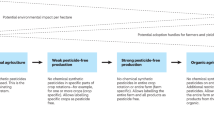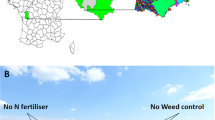Abstract
Achieving sustainable crop production while feeding an increasing world population is one of the most ambitious challenges of this century1. Meeting this challenge will necessarily imply a drastic reduction of adverse environmental effects arising from agricultural activities2. The reduction of pesticide use is one of the critical drivers to preserve the environment and human health. Pesticide use could be reduced through the adoption of new production strategies3–5; however, whether substantial reductions of pesticide use are possible without impacting crop productivity and profitability is debatable6–17. Here, we demonstrated that low pesticide use rarely decreases productivity and profitability in arable farms. We analysed the potential conflicts between pesticide use and productivity or profitability with data from 946 non-organic arable commercial farms showing contrasting levels of pesticide use and covering a wide range of production situations in France. We failed to detect any conflict between low pesticide use and both high productivity and high profitability in 77% of the farms. We estimated that total pesticide use could be reduced by 42% without any negative effects on both productivity and profitability in 59% of farms from our national network. This corresponded to an average reduction of 37, 47 and 60% of herbicide, fungicide and insecticide use, respectively. The potential for reducing pesticide use appeared higher in farms with currently high pesticide use than in farms with low pesticide use. Our results demonstrate that pesticide reduction is already accessible to farmers in most production situations. This would imply profound changes in market organization and trade balance.
This is a preview of subscription content, access via your institution
Access options
Access Nature and 54 other Nature Portfolio journals
Get Nature+, our best-value online-access subscription
$29.99 / 30 days
cancel any time
Subscribe to this journal
Receive 12 digital issues and online access to articles
$119.00 per year
only $9.92 per issue
Buy this article
- Purchase on Springer Link
- Instant access to full article PDF
Prices may be subject to local taxes which are calculated during checkout


Similar content being viewed by others
References
Foley, J. A. et al. Solutions for a cultivated planet. Nature 478, 337–342 (2011).
Tilman, D., Cassman, K. G., Matson, P. A., Naylor, R. & Polasky, S. Agricultural sustainability and intensive production practices. Nature 418, 671–677 (2002).
Liebman, M. & Gallandt, E. R. in Ecology in Agriculture (ed. Jackson, L. E. ) 291–343 (Academic, 1997).
Barzman, M. et al. Eight principles of integrated pest management. Agron. Sustain. Dev. 35, 1199–1215 (2015).
Lamichhane, J. R., Dachbrodt-Saaydeh, S., Kudsk, P. & Messéan, A. Towards a reduced reliance on conventional pesticides in European agriculture. Plant Dis. 100, 10–24 (2016).
Reganold, J. P., Glover, J. D., Andrews, P. K. & Hinman, H. R. Sustainability of three apple production systems. Nature. 410, 926–930 (2001).
Pimentel, D., Hepperly, P., Hanson, J., Douds, D. & Seidel, R. Environmental, energetic, and economic comparisons of organic and conventional farming systems. Bioscience 55, 573–582 (2005).
Cooper, J. & Dobson, H. The benefits of pesticides to mankind and the environment. Crop Prot. 26, 1337–1348 (2007).
Pardo, G., Riravololona, M. & Munier-Jolain, N. M. Using a farming system model to evaluate cropping system prototypes: are labour constraints and economic performances hampering the adoption of integrated weed management? Eur. J. Agron. 33, 24–32 (2010).
Blake, J., Wynn, S. & Jørgensen, L. N. Evaluation of the Benefits Provided by the Azole Class of Compounds in Wheat, and the Effect of Losing all Azoles on Wheat and Potato Production in Denmark, France and the UK. Report 1 – Impact of the Loss of all Azoles (ADAS UK Ltd, 2011).
Jacquet, F., Butault, J. P. & Guichard, L. An economic analysis of the possibility of reducing pesticides in French field crops. Ecol. Econ. 70, 1638–1648 (2011).
Di Tullio, E., Camanzi, L., Fontolan, F., Volpato, C. & Zucconi, S . The assessment of the economic importance of azoles in European agriculture: wheat case study (Nomisma, 2012).
Seufert, V., Ramankutty, N. & Foley, J. A. Comparing the yields of organic and conventional agriculture. Nature 485, 229–232 (2012).
Hossard, L. et al. Effects of halving pesticide use on wheat production. Sci. Rep. 4, 4405 (2014).
Jess, S. et al. European union policy on pesticides: implications for agriculture in Ireland. Pest Manag. Sci. 70, 1646–1654 (2014).
Lechenet, M. et al. Reconciling pesticide reduction with economic and environmental sustainability in arable farming. PLoS ONE 9, e97922 (2014).
Vasileiadis, V. P. et al. On-farm evaluation of integrated weed management tools for maize production in three different agro-environments in Europe: agronomic efficacy, herbicide use reduction, and economic sustainability. Eur. J. Agron. 63, 71–78 (2015).
Beketov, M. A., Kefford, B. J., Schäfer, R. B. & Liess, M. Pesticides reduce regional biodiversity of stream invertebrates. Proc. Natl Acad. Sci. USA 110, 11039–11043 (2013).
Wilson, C. & Tisdell, C. Why farmers continue to use pesticides despite environmental, health and sustainability costs. Ecol. Econ. 39, 449–462 (2001).
General Directorate of Health. Bilan de la qualité de l'eau au robinet du consommateur vis-à-vis des pesticides en 2013 (Ministère des affaires sociales, de la santé et des droits de la femme, 2015).
Rosset, P. M. & Altieri, M. A. Agroecology versus input substitution: a fundamental contradiction of sustainable agriculture. Soc. Nat. Resour. 10, 283–295 (1997).
Environmental Indicators for Agriculture, Volume 3: Methods and Results (OECD, 2001); http://www.oecd.org/tad/sustainable-agriculture/40680869.pdf
Feedipedia – Animal Feed Resources Information System (INRA CIRAD AFZ and FAO); http://www.feedipedia.org/
Indice des Prix des Produits Agricoles à la Production (IPPAP) et Indice des Prix d'Achat des Moyens de Production Agricole (IPAMPA) (Institut national de la statistique et des études économiques (Insee)); http://www.bdm.insee.fr/bdm2/choixTheme?code=20
Tibshirani, R. Regression shrinkage and selection via the lasso. J. R. Stat. Soc. Ser. B 58, 267–288 (1996).
James, G., Witten, D., Hastie, T. & Tibshirani, R . An Introduction to Statistical Learning (Springer, 2013).
Bastiaans, L., Paolini, R . & Baumann, D. T. Focus on ecological weed management: what is hindering adoption? Weed Res. 48, 481–491 (2008).
Rossi, V., Caffi, T. & Salinari, F. Helping farmers face the increasing complexity of decision-making for crop protection. Phytopathol. Mediterr. 51, 457–479 (2012).
Meynard, J. M. et al. Crop Diversification: Obstacles and Levers. Study of Farms and Supply Chains. Synopsis of the Study Report (INRA, accessed 29 October 2015); http://www6.paris.inra.fr/depe/content/download/3736/35824/version/1/file/Version±Anglaise±Diversification-8pages.pdf
R Core Team. R: A Language and Environment for Statistical Computing (R Foundation for Statistical Computing, 2014); https://www.R-project.org/
Benjamini, Y. & Hochberg, Y. Controlling the false discovery rate: a practical and powerful approach to multiple testing. J. R. Stat. Soc. Ser. B 57, 289–300 (1995).
Hill, A. M. O. & Smith, A. J. E. Principal component analysis of taxonomic data with multi-state discrete characters. Taxon. 25, 249–255 (1976).
Acknowledgements
We thank the farmers and farm advisors from the DEPHY network, the SCEP-DEPHY research project funded by the ONEMA (Office National de l'Eau et des Milieux Aquatiques). We also thank S. Cordeau and S. Petit for their relevant suggestions on the abstract. M.L.'s PhD fellowship was funded by Agrosolutions.
Author information
Authors and Affiliations
Contributions
N.M.J., D.M. and G.P. conceived the project; N.M.J. and G.P. contributed to data assembly; D.M. and F.D. contributed substantially to the methodology development; M.L. and F.D. analysed data; and M.L. wrote the paper, with substantial input from all authors.
Corresponding authors
Ethics declarations
Competing interests
The authors declare no competing financial interests.
Supplementary information
Supplementary Information
Supplementary Methods, Supplementary Figures 1–9, Supplementary Table 1. (PDF 1757 kb)
Rights and permissions
About this article
Cite this article
Lechenet, M., Dessaint, F., Py, G. et al. Reducing pesticide use while preserving crop productivity and profitability on arable farms. Nature Plants 3, 17008 (2017). https://doi.org/10.1038/nplants.2017.8
Received:
Accepted:
Published:
DOI: https://doi.org/10.1038/nplants.2017.8
This article is cited by
-
Identification of the estrogen-active compounds via integrating effect-directed analysis and non-target screening in soils of the northeastern China
Environmental Sciences Europe (2024)
-
The emergence of pesticide-free crop production systems in Europe
Nature Plants (2024)
-
Acting pre-emptively reduces the long-term costs of managing herbicide resistance
Scientific Reports (2024)
-
Mitigation of external costs of inorganic fertilizers with liquid fraction digestate
Biomass Conversion and Biorefinery (2024)
-
Group-aggregation of Hierarchical Containment Control for Homogeneous Multi-agent Systems in Precision Agriculture
International Journal of Control, Automation and Systems (2024)



